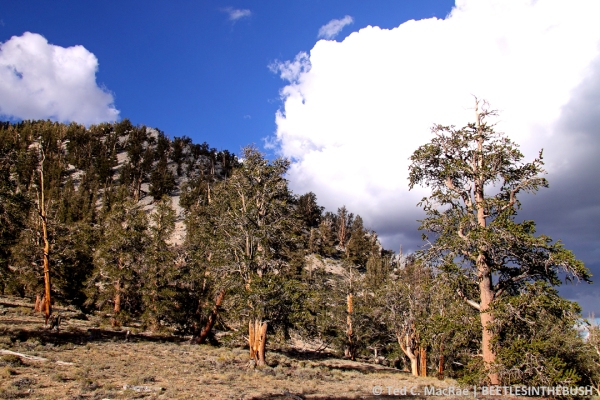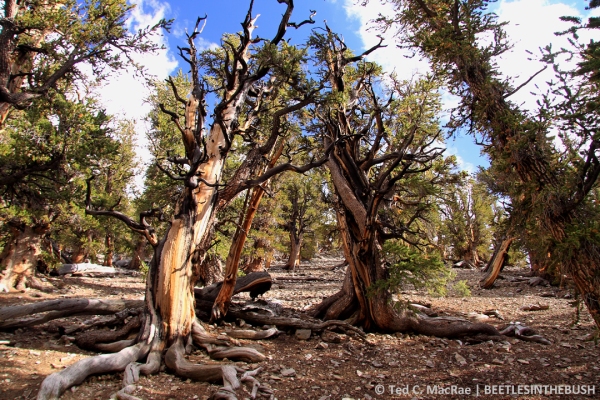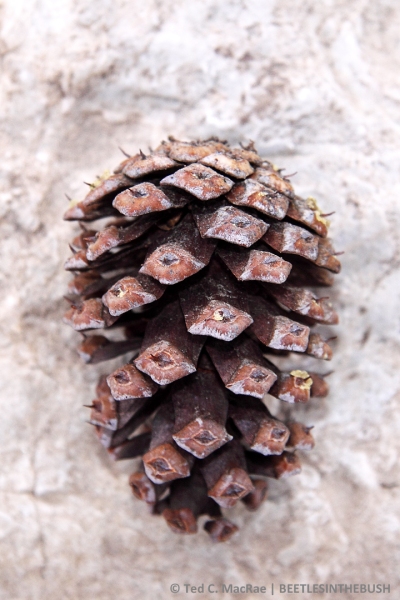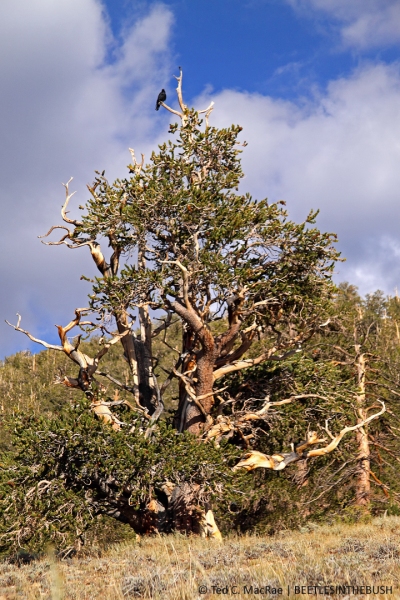
A view down towards Westgaard Pass.
I’ve mentioned before that I am never happier than when I am in the field, especially when it’s an extended insect collecting trip. One problem I face on these trips, however, is the conflict between my desire to stay focused on the task at hand (collecting insects) versus indulging my broader natural history interests—landscapes, botany, geology, etc. The urge to explore increases the further west I go, as the landscape becomes more diverse and unfamiliar, and reaches its zenith in the king of landscapes that is California.

Approaching Ancient Bristlecone Pine Forest from the south.
During our Great Basin collecting trip last August, field mate Jeff Huether and I visited the White Mountains near Bishop to look for Crossidius hirtipes nubilus, an isolated subspecies of longhorned beetle (family Cerambycidae) known only from the vicinity of Westgaard Pass. At 7,282′ elevation, the landscape around Westgaard Pass is beautiful enough, but we also knew that lying another 3,000′ above us was one of the most stunning landscapes that anyone even remotely interested in natural history could possibly imagine—Ancient Bristlecone Pine Forest (ABPF)!

Entering the Ancient Bristlecone Pine Forest.
While Jeff had previously visited this magical place, I’d not yet had the chance despite my five years in California back in the 1990s (too many places, not enough time!). I had mentioned this to Jeff earlier in the trip, so with small but adequate series of C. hirtipes nubilus in our bottles Jeff suggested we take a break from insect collecting and visit ABPF. I was excited enough about the prospect of seeing these ancient trees, but I could not have anticipated just how bizarre and otherworldly a landscape we were about to see!

Bristlecones growing in the harshest sites tend to be the longest-lived.
ABPF is, of course, named for the Great Basin bristlecone pines (Pinus longaeva) that occur here, one of three closely related pine species found in scattered, high mountain localities across the western U.S. and widely regarded to be the longest-lived of any non-clonal organism. The oldest known individual tree in the world, measured in 2012 at 5,062 years of age, is a bristlecone that occurs at this very site (although its identity and precise location are kept secret—for sadly obvious reasons), and nearly two dozen additional trees exceeding 4,000 years of age are known to occur here as well. True—there are clonal plants such as creosote bush and quaking aspen that are believed to survive as distinct genotypes for longer periods of time. However, the individual plants themselves are short-lived and quickly replaced by new sprouts from the clonal root mat. A 6,000-year old clonal patch of aspen may be technically older than a 4,000-year old bristlecone, but in my mind only the latter is bona fide ancient!

Most older bristlecones have trunks with large sections of exposed dead wood.
In the White Mountains, bristlecone pines are restricted to exposures of white dolomite (giving the mountains their name), usually between 10,000′ and 11,500′ in elevation. We could see the sharp demarcation between the white dolomite—heavily colonized by bristlecones—and non-dolomitic bedrock colonized by shrubs but devoid of pines as we approached ABPF from the south.

Dead bristlecones stand with main limbs intact for centuries.
Great Basin bristlecones occur also in the Inyo Mountains and other high mountains sites in Nevada and Utah. Most of these other sites have milder climates that offer more favorable growing conditions for the trees, and as a result the trees at these sites grow faster but—ironically—also die younger (Lanner 1999). Greater moisture availability and soils with more organic matter favor denser stands of trees as well as a richer shrub layer. This results in a greater fuel load that can carry fires, which are generally absent in the White Mountains groves with their widely spaced trees and sterile, rock substrate. Moreover, the harsh, dry conditions in the White Mountains inhibit the growth of fungi that can penetrate and colonize trunks at injury points, and there is a general lack of other threats that exist at milder sites such as bark beetles, sapsuckers, and even porcupines!

Bristlecone Pine Ancient Forest
Unlike other pines growing at high elevations, such as whitebark pine (Pinus albicaulis), which develops an almost shrubby, beaten-down form in the face of constant battering by fierce winter winds, Great Basin bristlecones grow solidly upright and develop massive branches supporting a spreading crown. As the trees get older, their outer branches become long and pendulous, drooping under the cumulative weight of numerous, tightly packed needle clusters that can remain on the tree for up to 40 years! (The needles of most pines are shed after just a few years.)

Bright, reddish-brown male catkins emerge near the tips of the densely needeled branches.
Most of the trees at ABPF grow on steep slopes of barren dolomite with virtually no soil layer, and the trunks of older trees usually bear large sections of exposed dead wood. Over the course of their very long lives, erosion of the rocks on the steep slopes around them gradually exposes roots, killing them and resulting in death of the trunk sections and branches that they feed. In many cases nearly the entire trunk is dead, but the tree lives on in a narrow ribbon of living bark snaking or spiraling up the trunk and connecting the last surviving roots to a single living branch.

A bristlecone sapling represents the promise of enduring life in the face of harsh conditions.
Eventually death does come, but it can take centuries for the dry, cold air to decompose the standing carcass and even millenia for the hard, resinous wood to break down completely once the tree finally does fall. The oldest existing wood at ABPF has been dated to more than 9,000 years old! It is almost incomprehensible to imagine stepping over a log that began life as a sapling shortly after the last glacial retreat and the arrival of the first humans to step foot in North America!

Bristlecones are named for, well.. the bristles on their cones!
Why do Great Basin bristlecones live so long? It’s tempting to presume that the dry, high elevation environment, with its long, harsh winters and short, cool growing season enables an unusually slow metabolism that somehow translates to longevity. There is no evidence to support this, however. Perhaps characteristics such as its extremely decay-resistant wood play a part, but there are a few other species of pine that are also extraordinarily long-lived, yet still fall far short of the great ages that can be attained by Great Basin bristlecone pine. These include limber pine (Pinus flexilis), which co-occurs with Great Basin bristlecone pine in the White Mountains, but this species maxes out at about 2,000 years of age. Likewise, Rocky Mountain bristlecone pine (Pinus aristata) in Colorado can reach around 2,500 years of age. (Interestingly, limber pine occurs here as well, but in this area it reaches at best only about 1,500 years of age.) Even Great Basin bristlecones themselves growing at other sites, as noted above, are unable to match the longevity of the trees growing here in the White Mountains. Perhaps, as California conifer expert Ronald Lanner remarked, the question is not why these trees “live so long”, but why they “take so long to die”.

A raven perches atop a fine, massively trunked specimen.
REFERENCE:
Lanner, R. M. 1999. Conifers of California. Cachuma Press, Los Olivos, California, 274 pp. [description].
Copyright © Ted C. MacRae 2014
So very fascinating!
Among the healing powers of the internet, is its ability to carry passengers to long forgotten places, and places they have never seen. Thank you for bringing the Healing Garden gardener back to this extraordinary place on earth. As mountaineers and botanists discover, there are ancient trees at certain altitudes around the Ring of Fire. Thank you for conveying the majesty and wonder of these living creatures. Westgaard Pass and the Inyo Forest are wonders of our heritage and treasured Elders occupying a specialized habitat in our Pacific Rim mountains. As the most ancient living creatures we are likely to encounter on our journey through life, certainly they are worthy of protecting and preserving. – The Healing Garden gardener
Awesome post, Ted! What amazing trees! I probably never would have heard about that place, thanks for writing so eloquently and informatively about it. Hopefully I’ll visit it someday.
Pingback: Links 2/12/14 | Mike the Mad Biologist
Very nice all images… 😉
Amazing trees, and great pictures!
But it looks like rather sparse bug habitat. Or am I wrong about that?
We saw numerous emergence holes from buprestid and cerambycid beetles in dead bristlecone pine wood. Also ants, and though not in flower there were a variety of small shrubs and herbaceous plants that probably attract pollinators during spring.
very interesting.
Wow, fantastic bristlecone photos! They’re very evocative and striking.